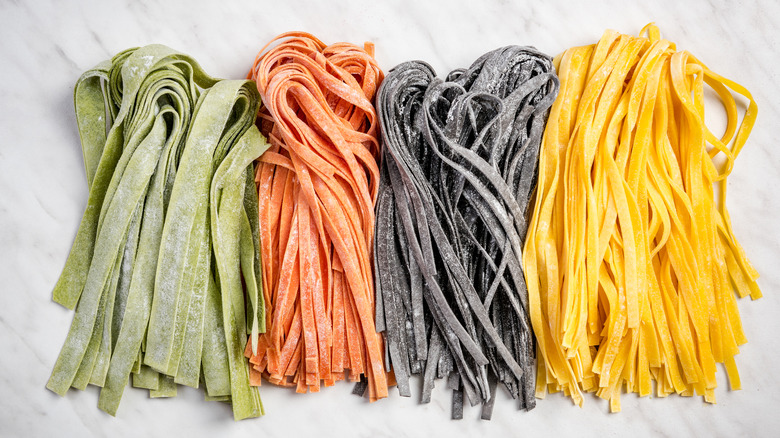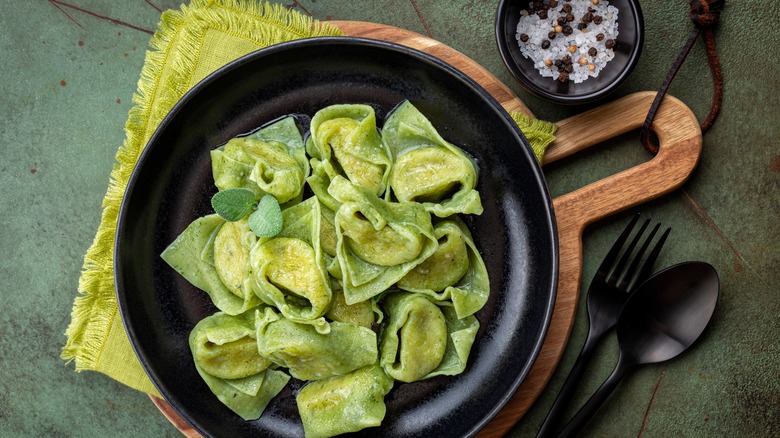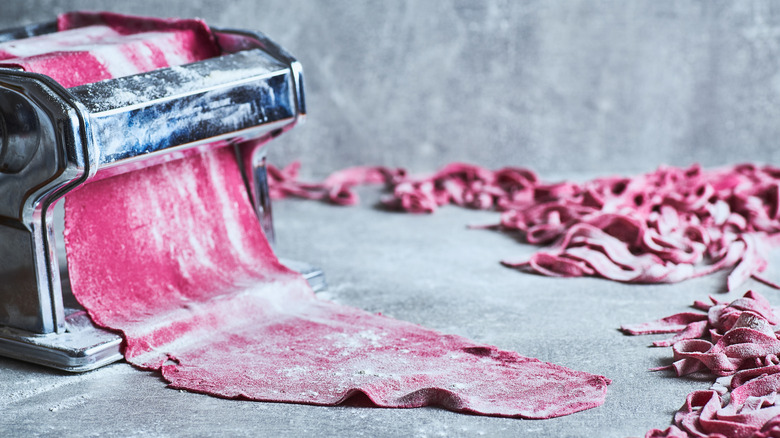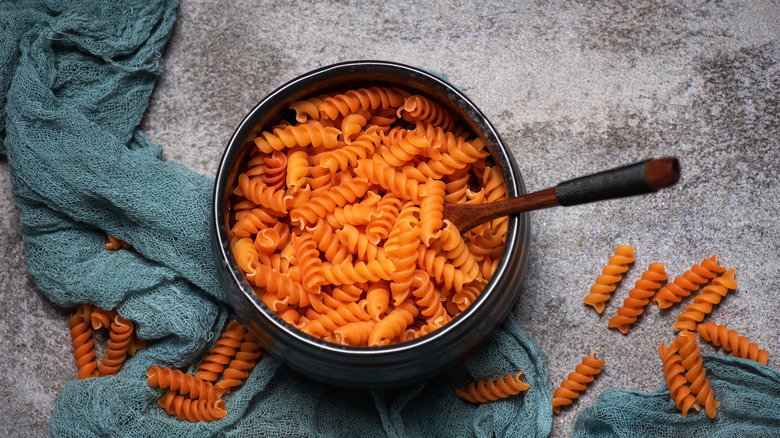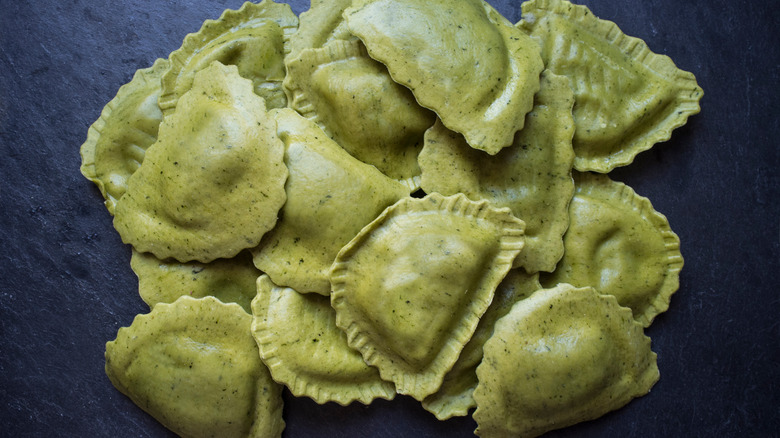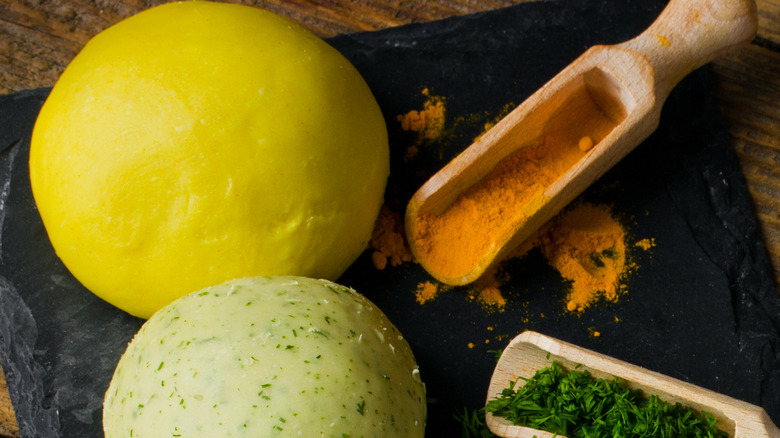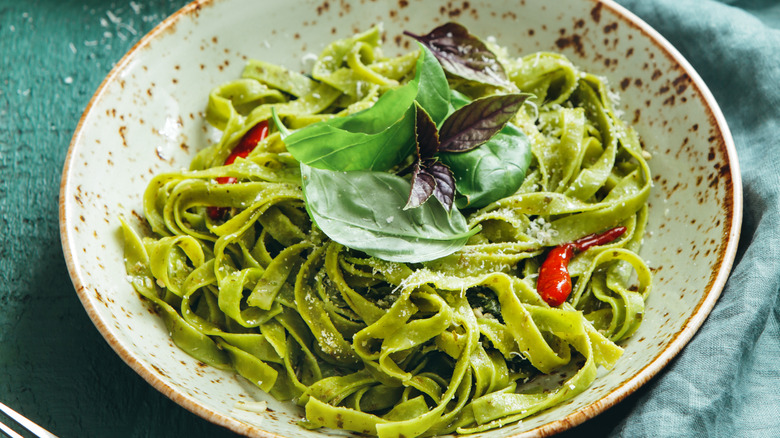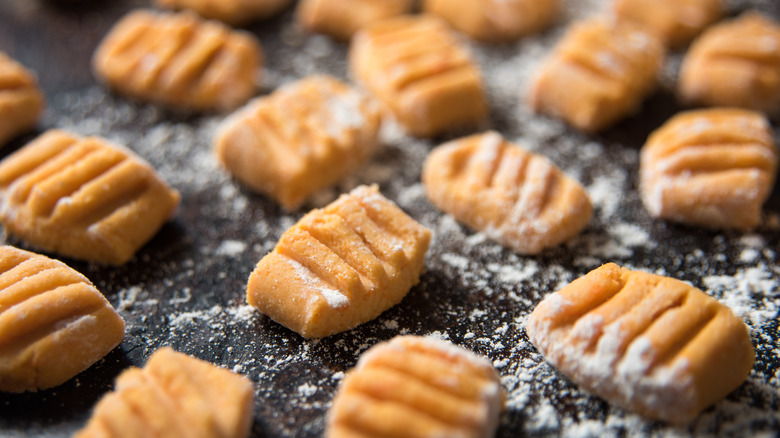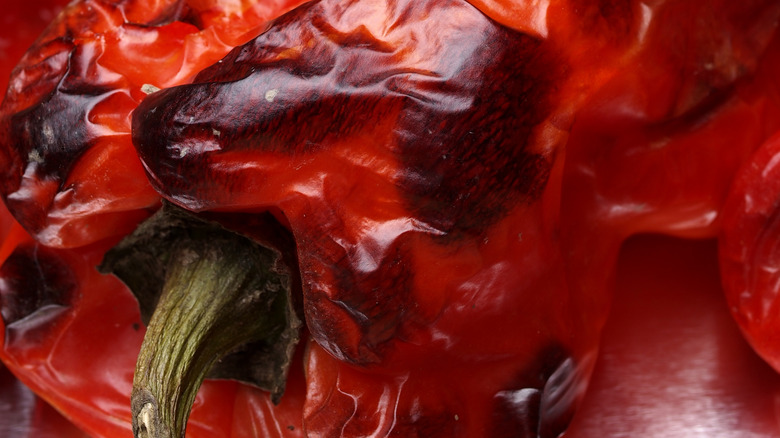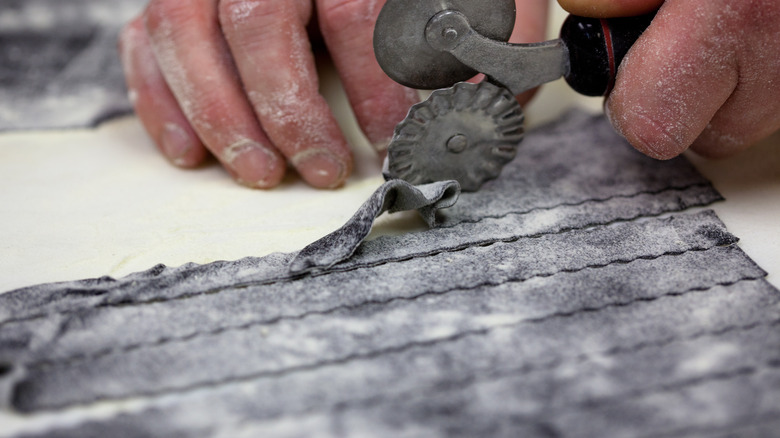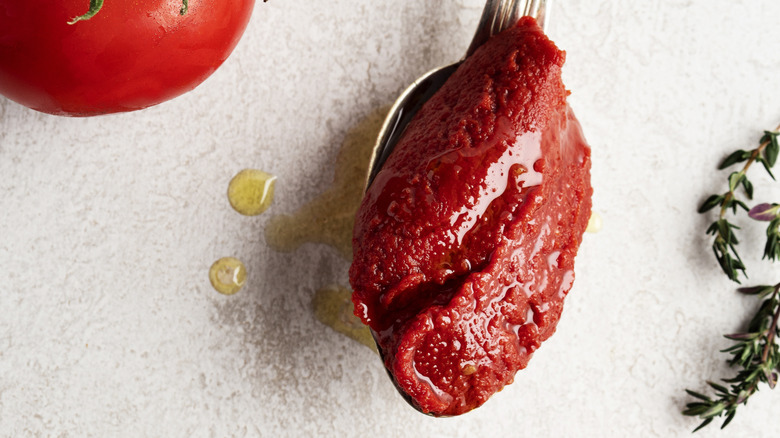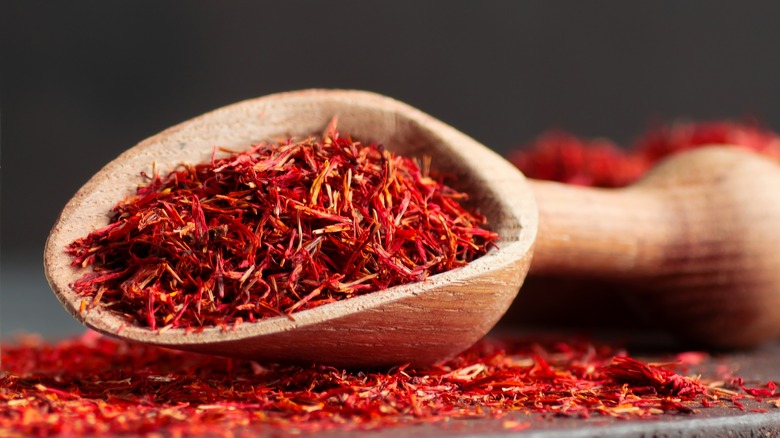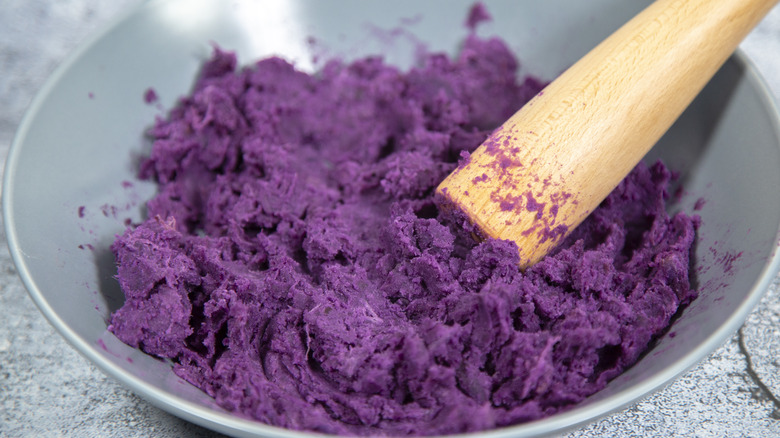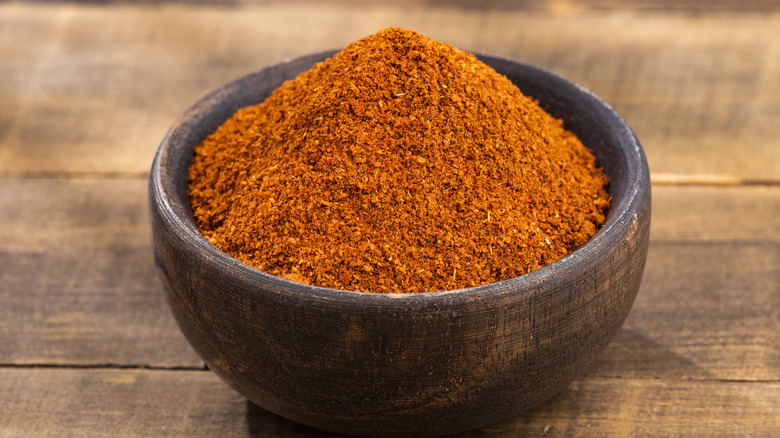13 Ways To Add Flavor And Color To Fresh Pasta
Whether you're warming up with a bowl of chili mac and cheese on a frigid winter night or wooing your love interest with a plate of homemade linguini marinara and a bottle of fancy red wine served by candlelight, the options of toppings, sauces, and pasta itself are utterly endless. However, everyone knows that when it comes to selecting which pasta to use, homemade is always best. Not only are the flavors and textures unmatched, but you have complete control over every last detail. And while following a recipe or pasta-making tips is always a good idea, consider the variations you could implement. In fact, there are plenty of ways to add flavor and color to fresh pasta that could make the process and end result even more memorable.
Ever notice those green, pink, orange, or black noodles at your local Italian eatery, or even on the shelves of your town's gourmet market? If you're getting a quality product, those shells are dyed naturally, without food coloring. Instead, they likely use nature's food coloring: vegetables. Not only will this add color to your noodles, but flavor as well. Use your culinary creativity to add a little pizzazz to your pasta.
Spinach
While we don't always want our food to turn green, fresh green homemade pasta just seems healthier than the traditional pastel yellow hue. It's a great way to sneak leafy greens into your diet without choking down a forkful of steamed spinach. In addition, it can give your pasta a subtle grassy flavor that can be quite refreshing when paired with the right sauces. It's an easy add because spinach is so quick to steam and has a bright green pigment that will be sure to dye your flour and egg mixture.
There are several ways to add spinach to fresh pasta, resulting in different aesthetics and nutrient contents. Perhaps the easiest way to do it is by blending steamed spinach with one of your eggs, or some of your egg whites. Blend until the mixture is completely puréed, and then whisk it into your pile of flour. You can also add steamed and chopped spinach, which tends to have a confetti-like appearance when all is said and done. The last option is to juice spinach, which requires a juicer or a high-speed blender and cheesecloth, and mix the liquid into your eggs before whisking it with the flour. This may throw off your liquid-to-dry ingredient ratio, so keep that in mind as you add flour. There are many ways that pasta gets its different colors, but most of the time if you're enjoying green pasta, it has been dyed with spinach.
Beets
Perhaps the boldest and most fun color to dye your pasta is bright pink. And while it may look almost unnatural, the process to produce this color is just about as earthy as you can get. That's because nature's red, pink, and orange dye can come from beets, which makes for a fantastic red food coloring substitute in cooking. Seriously, you can even tie-dye a shirt using beet juice, which is why it's important to be mindful of keeping it off of your hands and clothes.
Although some of you may picture beets as earthy, crunchy root vegetables that taste like dirt, they're actually incredibly sweet and are used to create much of the sugar produced in the United States. They come in several shades, but we recommend using a classic red beet to achieve a bright pink pasta. Roast or boil the beets until soft, and blend them in a high-speed blender. You can also use beet juice which is easy to make, or for an even simpler option, you can often find beet juice at the grocery store. Blend your mash or juice in with an egg or two before introducing it into the flour. If you opt for beet juice, add a little extra flour to balance the liquid ratio. This pasta will have a slightly sweet undertone and pairs beautifully with cream-based, broth-based, and oil-based sauces so that it has a chance to show off its vibrancy.
Carrots
Vegetable enthusiasts know that carrots are loaded with beta-carotene, which is a pigment that comes from plants. In fact, the name beta-carotene originates from the Latin word for carrot, so it's no wonder that carrots make such an incredible natural food coloring. And while carrots are known for their bright orange appearance, they actually come in several colors including purple, hot pink, and white. White carrots can't do much for us in the way of dying our pasta fun colors, but pink, purple, and orange sure can!
If you enjoy the flavor of carrots, the key to getting more flavor out of carrots is to buy them smaller. In addition, the actual color of your carrot can tell you quite a bit about the carrot's flavor. So choose your variety and size wisely. Be sure to steam and blend, or juice your carrots before integrating them into the dough. Enjoy bright orange pasta, with sweet and earthy undertones of flavor. Carrot pasta pairs well with fresh flavors, creamy sauces, and of course, garlic with olive oil and herbs.
Kale
Like spinach, kale can help to dye your pasta a deep green color. However, if you're going for that confetti-like appearance, kale is easier to work with. This is because kale is much more fibrous, and keeps its shape when cooked more so than spinach, which has a tendency to break down and become mushy. Kale also has a slightly deeper and darker pigment, with cooler tones that might better match the aesthetic you're trying to achieve.
Mince your kale into uber-small pieces before steaming it in a little water. Strain the water thoroughly to prevent the green-pigmented water from dying too much of the flour if you're looking for high-contrast flecks. Once you begin mixing your eggs in with the flour, be sure to begin introducing small amounts of the steamed and chopped kale as well. In the end, after the pasta has been rolled out you'll notice that those green flecks are nice and prominent. This is a surefire way to add both nutrients and color to your fresh pasta.
Turmeric
If you've ever worked with turmeric before, it's likely that you're aware of how successfully it can be used as a dye. This means on your skin, your countertops, your sponges, your clothes... the list goes on and on. In this case, when we are looking for ways to add flavor and color to fresh pasta, turmeric is a perfect candidate. You can use either freshly ground and juiced turmeric for an organic pulpy look, or turmeric spice for a more even-tone, no-fuss option.
If you've opted to use dried turmeric powder, then mix it right into your flour. The juice can be mixed in with the eggs. Just a little bit of turmeric can do the trick, but feel free to add as much as you desire. However, keep in mind that while you're letting your dough rest (a step you can't forget before rolling fresh pasta dough), the color of the turmeric will intensify. Consider adding freshly ground black pepper to your dough as well, as it will help to intensify and activate the curcumin, the active ingredient that makes turmeric such a powerful anti-inflammatory. Turmeric has a slightly spicy and earthy quality to it, but won't overpower your sauce. Pair with seafood, white meats, and root vegetable pasta dishes.
Basil
When it comes to the best ingredients to take pasta dishes to the next level, it's hard to forget about fresh herbs. And any time pasta is on the table, it's impossible to ignore its natural pairing with basil. Not only has basil been accompanying pasta dishes from creamy to tomatoey since the beginning of time, but it's generally easily accessible and not too difficult to grow at home. Instead of relying on pesto, or a basil garnish to elevate your pasta dish, why not toss it right into the dough?
Basil can either be blended with eggs to create a bright green glow or can be chopped up and mixed in which results in little flecks of color. For mixing fresh herbs into pasta, it's nice to be able to see exactly where the flavor is coming from, so consider using the confetti technique. It will remind those enjoying your homemade creation of pesto, and they will appreciate being able to see that you've used fresh ingredients. Of course, basil will have a similar look to spinach or kale, but will be much more easily distinguished in both fragrance and flavor. Enjoy the sweet and spicy flavors of the fresh herb, and enjoy it with virtually any Mediterranean-style pasta sauce.
Sweet potatoes
Another beta-carotene-rich vegetable that's power-packed with nutrients is the sweet potato. Bright orange in appearance, this flavorful root vegetable is loaded with flavor and starchy goodness. In fact, some pasta dishes like gnocchi are made purposefully with potatoes because of their starchy, doughy mouthfeel. These little pasta dumplings are the perfect candidate to be brightened by the stunningly vibrant colors of sweet potatoes, and their delicious flavors.
Simply use sweet potatoes in place of potatoes in your favorite gnocchi recipe, or use a dedicated sweet potato gnocchi recipe. You can also mix cooked sweet potatoes right into your standard pasta dough, but be sure not to overcrowd the flour or eggs in order to avoid a crumbly texture. If you opt to use mashed sweet potato in your standard pasta dough, it will result in a subtly orange pasta, and will not be as deeply rich as if you were to use carrot juice. This pastel coloring can be quite sophisticated, and the sweet undertones will pair beautifully with olive oil and crispy sage. The starchy texture can be quite pleasing if done right.
Roasted red peppers
Red peppers are never difficult to spot in the produce section because of their bright, deep color. And while red peppers are simply fully ripened green peppers, their flavor varies greatly. That's right, the difference between different colors of bell peppers depends entirely on how ripe they are. And the riper they get, the sweeter the flavor, which is why red peppers are so popular and versatile.
If you don't know how to roast bell peppers on the stove, oven, or grill, then spend a little time doing some research on the internet. It's actually quite easy, and the key is to char the skin enough so that it peels off easily. Once the peppers are soft, and the charred skin has been peeled off, it's time to get blending. Raw red peppers will blend into a foamy pink mixture, but once some of their moisture has cooked off and the sugars start to caramelize, the color becomes more intense and so does the flavor. Mix the blend right into the dough, and enjoy a pinkish-red pasta with sweet and charred undertones of flavor. Pair your roasted red pepper pasta with soft cheeses, olives, and fresh herbs.
Squid ink
Although most of our bright and beautiful natural dyes are made from vegetables, it's also possible to create black pasta with ingredients found in nature. In fact, squid ink can be used as quite a successful dye, so keep it far away from your clothing and wooden spoons. Although this may seem like a specialty product that's hard to get your hands on, you can actually find it in major grocery stores, and when in doubt, on Amazon. Look for squid or cuttlefish ink in a small jar, and make the most epic, black-colored pasta dishes. If you're vegan, you can opt for activated charcoal instead.
Because squid ink is a liquid, you'll want to avoid a common mistake when making fresh pasta, and that's to throw off your liquid-to-dry-ingredient ratio when adding alternative ingredients to the dough. Be sure to add it slowly to the liquids so that when kneaded it will evenly distribute. Use gloves if you're worried about dying your hands, although you will be able to wash the ink out eventually. Pair with seafood pasta recipes, especially squid or cuttlefish, with a brothy or buttery citrus sauce.
Tomato paste
Have you ever washed your plastic Tupperware a dozen times after enjoying pasta with tomato sauce, and still, that infamous orange glow will not come off? That is the magic of tomatoes, which anyone who's worn a white t-shirt while enjoying a tomato-based pasta sauce knows first-hand. While tomato sauce itself is too liquidy and chunky to add to pasta dough, you can certainly use tomato paste to achieve an orange glow. In fact, tomato paste is quite common when making naturally dyed fresh pasta, because tomatoes and pasta go hand in hand like no other.
Before adding it right into your dough, consider browning tomato paste first. Heating it will not only help to mellow the acidic and metallic taste of the paste, but it will also help to intensify the sweet and umami flavors that we love so much from tomatoes. Of course, tomato paste pasta can be paired with a homemade marinara, but it also goes beautifully with cream-based sauces to create almost a vodka sauce flavor, and to help balance the rich mouthfeel with some sweet acidity.
Saffron
We're about to go full gourmet here by suggesting the addition of the most expensive spice on the shelf. But the truth is that you don't need to use a lot of it, and the cost is worth it for the end result. Before you roll your eyes at the bougie ingredient, keep in mind that there is, in fact, a reason why saffron is so expensive. Each red and gold stigma must be hand separated from the flower, a process that cannot be automated. And if you're looking for that incredible scent and fragrance, it's important to be able to spot the difference between real and fake saffron before purchasing the spice. Once you have your hands on the real thing, consider folding it into your pasta dough.
Although saffron has a crimson-red appearance, it does not make for a very successful red dye. Instead, it will turn your pasta bright yellow, more intensely than egg yolks, and leave little flecks of the red stigma to add pops of red and orange color to the noodles. The flavor is floral, subtly sweet, and earthy, and it goes great with seafood sauces, fresh herbs, and mild Mediterranean sauces.
Purple potatoes
If you enjoy good starchy pasta and love pastel hues, it's time to start adding purple potatoes to your homemade fresh pasta dough. Unless gnocchi is the name of the game, then your potato ratio won't be enough to make the pasta deep purple, but it's certainly enough to change its appearance. Peel, boil or steam, and mash your Stokes Purple sweet potatoes, Murasaki sweet potatoes, Okinawan sweet potatoes, or Charleston sweet potatoes, all of which can be found in the United States and have purple flesh.
Fold the starchy mash into the dough of your pasta thoroughly until the entire ball is even-toned. Run it through your pasta press, or roll it out with your rolling pin. This type of pasta is particularly good when made into ravioli, or a wider type of pasta like lasagna. Enjoy purple potato ravioli with sage and pumpkin ricotta, or other fall-time classics. Because of the subtle hue, you'll want to be sure to use a light-colored sauce, or a thin sauce with a white wine, broth, or olive oil base. These purple potatoes range in sweetness, so decide on which sauce you're going to pair with them before you select your variety.
Paprika
Although paprika may seem like a foreign spice, made from a ground-up pod, seed, or leaf, it's actually made from dried peppers. And although that's not quite everything you need to know about paprika, this fact may have come as a surprise to even well-seasoned home cooks. This is why it's sweet, earthy, and even slightly fruity in flavor, like a pepper. And as you know, paprika is bright red and ranges from a brick or rust color to bright stop-light red.
Paprika is rather easy to incorporate into fresh pasta and will add both subtle notes of flavor and a warm glow. Mix paprika in with your flour, and don't hesitate to use quite a bit of it. Choose a variety of paprika to best fit your dish, and although it can complement marinara sauce beautifully, consider it in a dish where it will have more of a chance to shine. Paprika compliments seafood beautifully and can help to elevate any spicy sauce. It can also pair delectably with citrus and of course sweet herbs and aromatics like basil and garlic. Enjoy the deep warmth of paprika pasta alongside roasted vegetables, for a sophisticated and garden-fresh main course.
